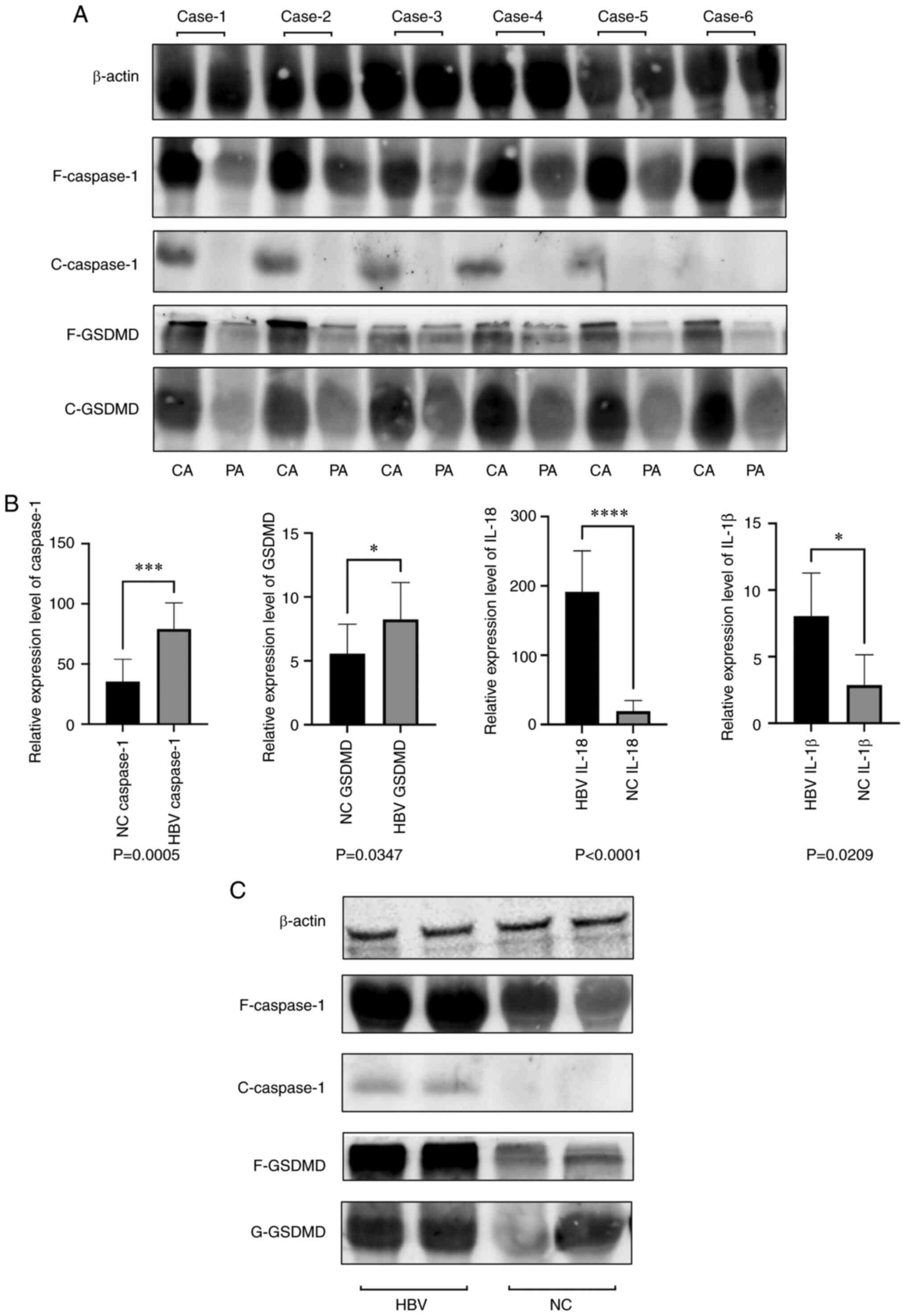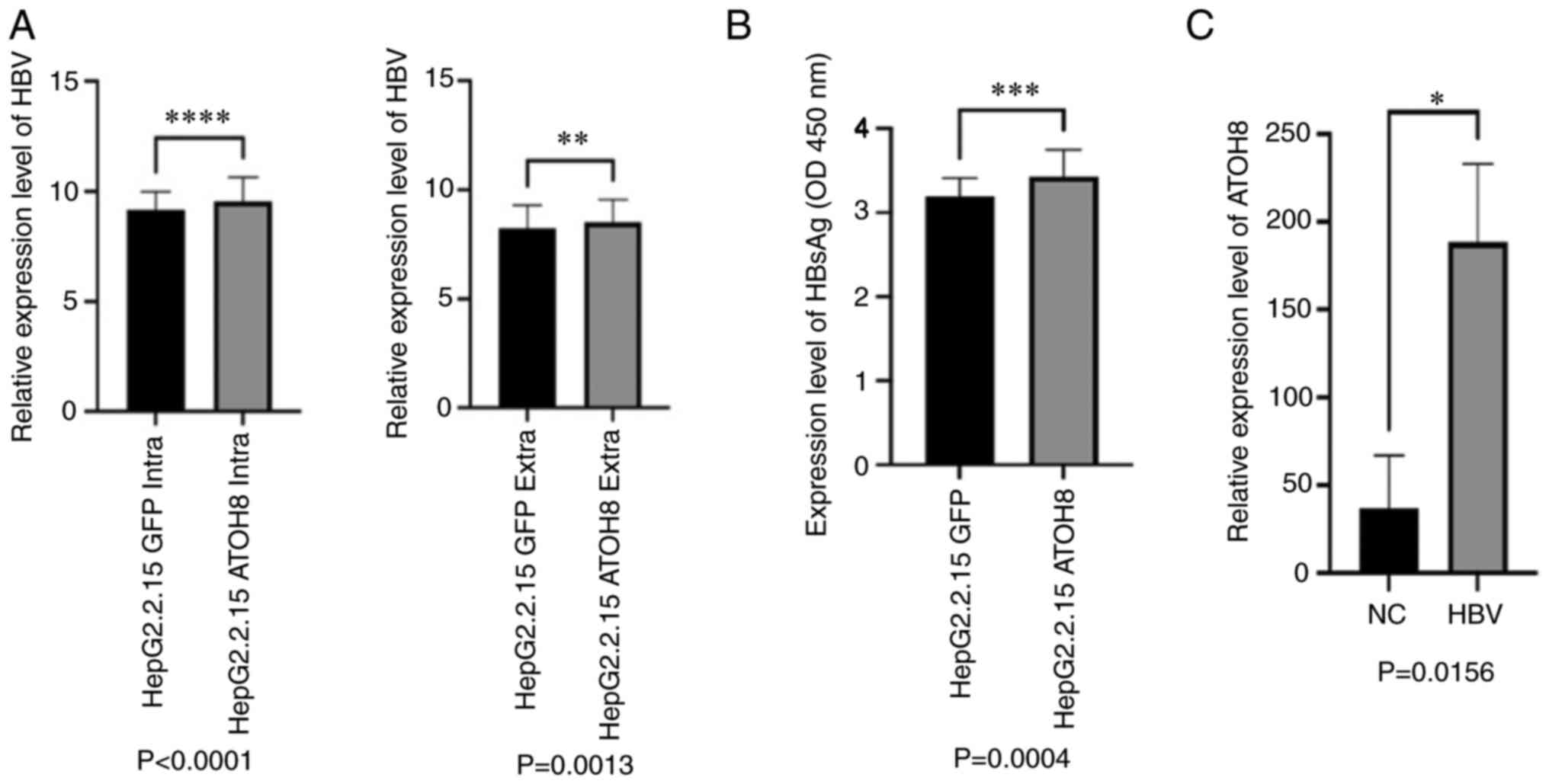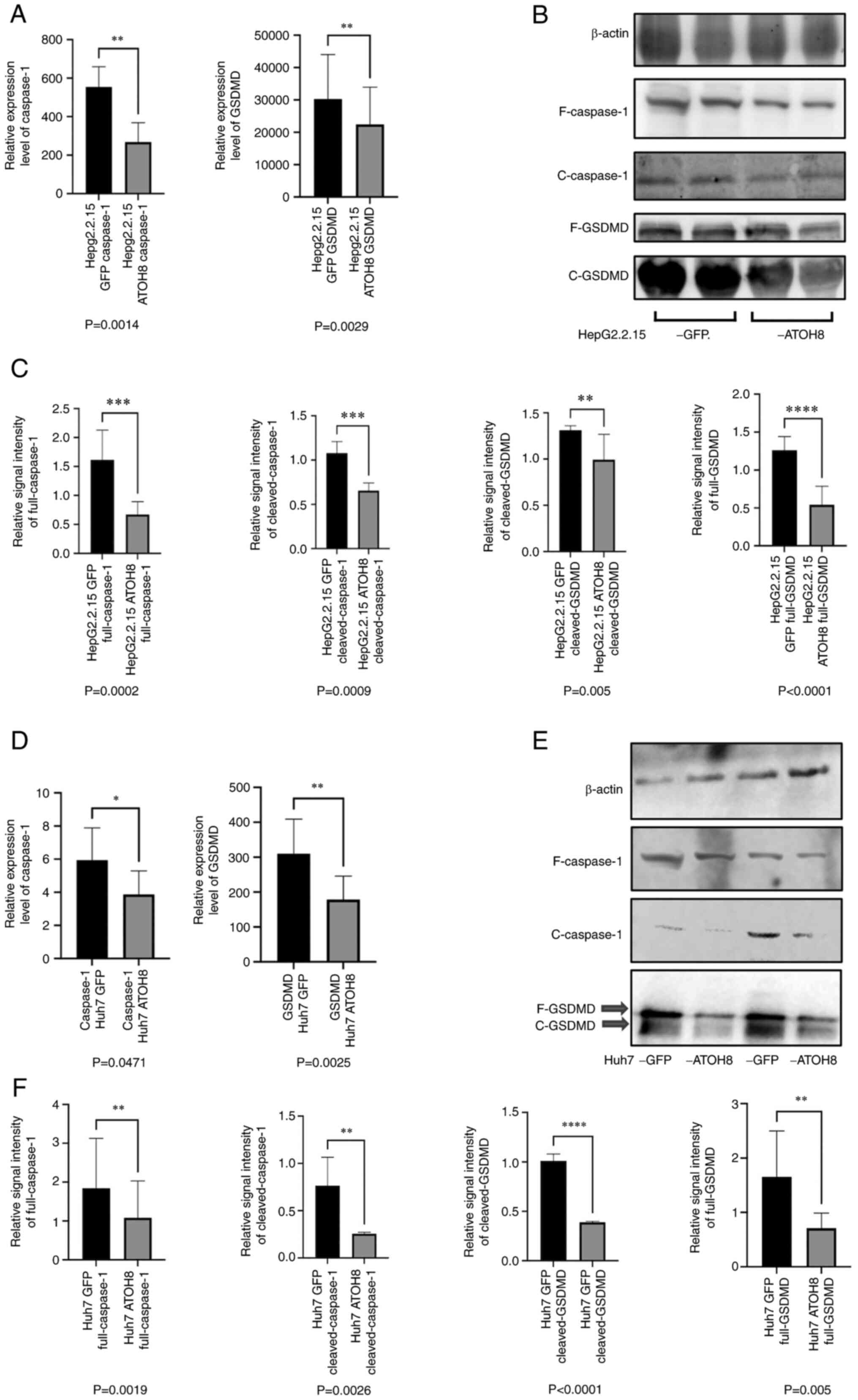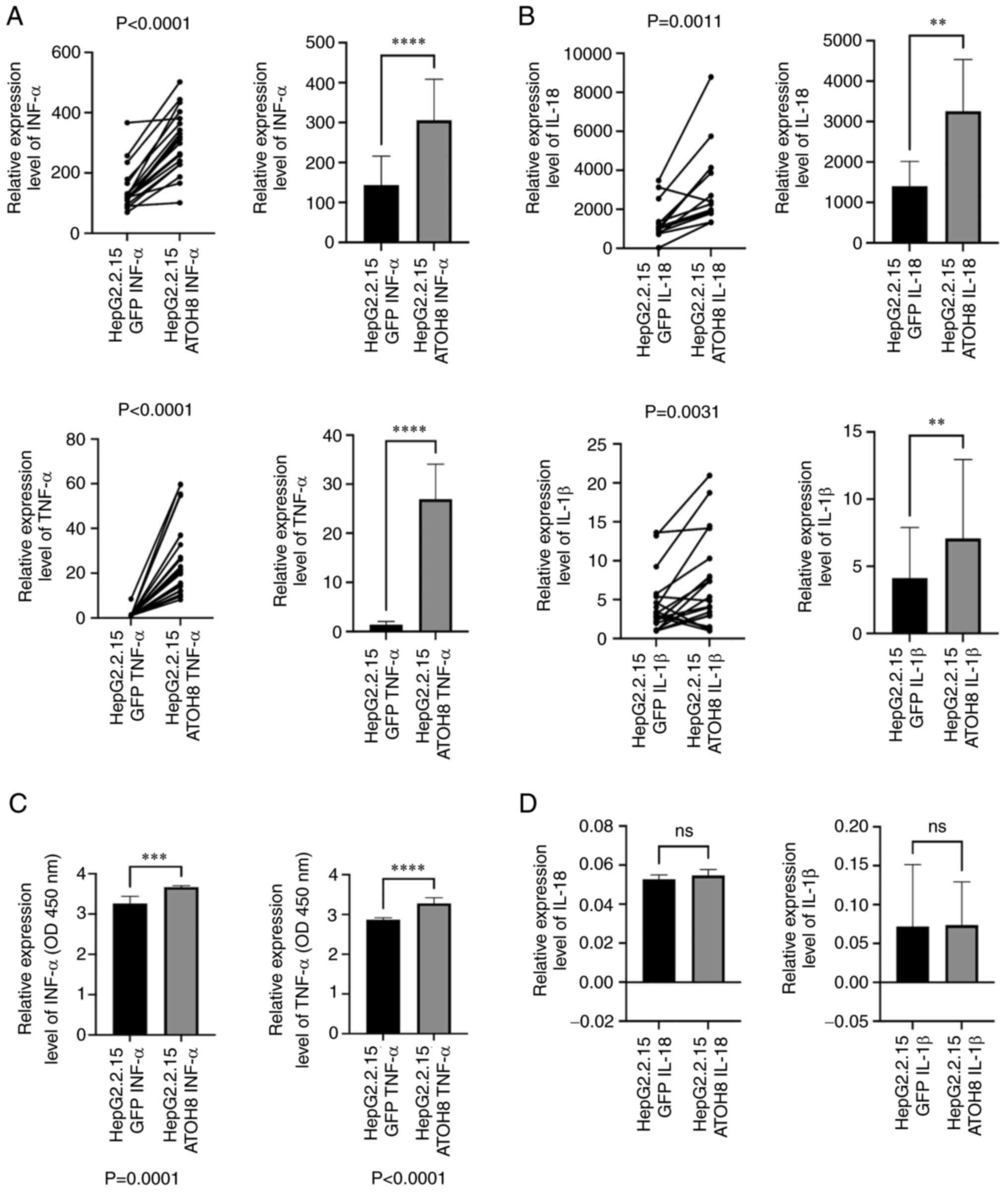|
1
|
Nicolini LA, Orsi A, Tatarelli P, Viscoli
C, Icardi G and Sticchi L: A global view to HBV chronic infection:
Evolving strategies for diagnosis, treatment and prevention in
immunocompetent individuals. Int J Environ Res Public Health.
16:33072019. View Article : Google Scholar : PubMed/NCBI
|
|
2
|
Pollicino T and Caminiti G:
HBV–Integration studies in the clinic: Role in the natural history
of infection. Viruses. 13:3682021. View Article : Google Scholar : PubMed/NCBI
|
|
3
|
Zhou L, He R, Fang P, Li M, Yu H, Wang Q,
Yu Y, Wang F, Zhang Y, Chen A, et al: Hepatitis B virus rigs the
cellular metabolome to avoid innate immune recognition. Nat Commun.
12:982021. View Article : Google Scholar : PubMed/NCBI
|
|
4
|
Wieland S, Thimme R, Purcell RH and
Chisari FV: Genomic analysis of the host response to hepatitis B
virus infection. Proc Natl Acad Sci USA. 101:6669–6674. 2004.
View Article : Google Scholar : PubMed/NCBI
|
|
5
|
Lebossé F, Testoni B, Fresquet J,
Facchetti F, Galmozzi E, Fournier M, Hervieu V, Berthillon P, Berby
F, Bordes I, et al: Intrahepatic innate immune response pathways
are downregulated in untreated chronic hepatitis B. J Hepatol.
66:897–909. 2017. View Article : Google Scholar : PubMed/NCBI
|
|
6
|
Luangsay S, Gruffaz M, Isorce N, Testoni
B, Michelet M, Faure-Dupuy S, Maadadi S, Ait-Goughoulte M, Parent
R, Rivoire M, et al: Early inhibition of hepatocyte innate
responses by hepatitis B virus. J Hepatol. 63:1314–1322. 2015.
View Article : Google Scholar : PubMed/NCBI
|
|
7
|
Visvanathan K, Skinner NA, Thompson AJV,
Riordan SM, Sozzi V, Edwards R, Rodgers S, Kurtovic J, Chang J,
Lewin S, et al: Regulation of toll-like receptor-2 expression in
chronic hepatitis B by the precore protein. Hepatology. 45:102–110.
2007. View Article : Google Scholar : PubMed/NCBI
|
|
8
|
Li M, Sun R, Xu L, Yin W, Chen Y, Zheng X,
Lian Z, Wei H and Tian Z: Kupffer cells support hepatitis B
virus-mediated CD8+ T cell exhaustion via hepatitis B core
antigen-TLR2 interactions in mice. J Immunol. 195:3100–3109. 2015.
View Article : Google Scholar : PubMed/NCBI
|
|
9
|
Teng Y, Xu Z, Zhao K, Zhong Y, Wang J,
Zhao L, Zheng Z, Hou W, Zhu C, Chen X, et al: Novel function of
SART1 in HNF4α transcriptional regulation contributes to its
antiviral role during HBV infection. J Hepatol. 75:1072–1082. 2021.
View Article : Google Scholar : PubMed/NCBI
|
|
10
|
Zhang Y, Chen X, Cao Y and Yang Z: Roles
of APOBEC3 in hepatitis B virus (HBV) infection and
hepatocarcinogenesis. Bioengineered. 12:2074–2086. 2021. View Article : Google Scholar : PubMed/NCBI
|
|
11
|
Lak R, Yaghobi R and Garshasbi M:
Importance of miR-125a-5p and miR-122-5p expression in patients
with HBV infection. Cell Mol Biol (Noisy-le-grand). 66:1–8. 2020.
View Article : Google Scholar : PubMed/NCBI
|
|
12
|
Oropeza CE, Tarnow G, Sridhar A, Taha TY,
Shalaby RE and McLachlan A: The regulation of HBV transcription and
replication. Adv Exp Med Biol. 1179:39–69. 2020. View Article : Google Scholar : PubMed/NCBI
|
|
13
|
Xu M, Huang S, Dong X, Chen Y, Li M, Shi
W, Wang G, Huang C, Wang Q, Liu Y, et al: A novel isoform of ATOH8
promotes the metastasis of breast cancer by regulating RhoC. J Mol
Cell Biol. 13:59–71. 2021. View Article : Google Scholar : PubMed/NCBI
|
|
14
|
Song Y, Pan G, Chen L, Ma S, Zeng T, Chan
THM, Li L, Lian Q, Chow R, Cai X, et al: Loss of ATOH8 increases
stem cell features of hepatocellular carcinoma cells.
Gastroenterology. 149:1068–1081.e5. 2015. View Article : Google Scholar : PubMed/NCBI
|
|
15
|
Chen L, Yang J, Wang Y, Wu N, Li X, Li J,
Huang Y and Cheng J: ATOH8 overexpression inhibits the tumor
progression and monocyte chemotaxis in hepatocellular carcinoma.
Int J Clin Exp Pathol. 13:2534–2543. 2020.PubMed/NCBI
|
|
16
|
Yu P, Zhang X, Liu N, Tang L, Peng C and
Chen X: Pyroptosis: Mechanisms and diseases. Signal Transduct
Target Ther. 6:1282021. View Article : Google Scholar : PubMed/NCBI
|
|
17
|
Song L, Pei L, Yao S, Wu Y and Shang Y:
NLRP3 inflammasome in neurological diseases, from functions to
therapies. Front Cell Neurosci. 11:632017. View Article : Google Scholar : PubMed/NCBI
|
|
18
|
Pezuk JA: Pyroptosis in combinatorial
treatment to improve cancer patients' outcome, is that what we
want? EBioMedicine. 41:17–18. 2019. View Article : Google Scholar : PubMed/NCBI
|
|
19
|
Zhang L, Zeyu W, Liu B, Jang S, Zhang Z
and Jiang Y: Pyroptosis in liver disease. Rev Esp Enferm Dig.
113:280–285. 2021.PubMed/NCBI
|
|
20
|
Ługowska A, Hetmańczyk-Sawicka K,
Iwanicka-Nowicka R, Fogtman A, Cieśla J, Purzycka-Olewiecka JK,
Sitarska D, Płoski R, Filocamo M, Lualdi S, et al: Gene expression
profile in patients with Gaucher disease indicates activation of
inflammatory processes. Sci Rep. 9:60602019. View Article : Google Scholar : PubMed/NCBI
|
|
21
|
Jiang Y, Han Q, Zhao H and Zhang J: The
mechanisms of HBV-induced hepatocellular carcinoma. J Hepatocell
Carcinoma. 8:435–450. 2021. View Article : Google Scholar : PubMed/NCBI
|
|
22
|
Yu X, Lan P, Hou X, Han Q, Lu N, Li T,
Jiao C, Zhang J, Zhang C and Tian Z: HBV inhibits LPS-induced NLRP3
inflammasome activation and IL-1β production via suppressing the
NF-κB pathway and ROS production. J Hepatol. 66:693–702. 2017.
View Article : Google Scholar : PubMed/NCBI
|
|
23
|
Xie WH, Ding J, Xie XX, Yang XH, Wu XF,
Chen ZX, Guo QL, Gao WY, Wang XZ and Li D: Hepatitis B virus X
protein promotes liver cell pyroptosis under oxidative stress
through NLRP3 inflammasome activation. Inflamm Res. 69:683–696.
2020. View Article : Google Scholar : PubMed/NCBI
|
|
24
|
Wei Q, Mu K, Li T, Zhang Y, Yang Z, Jia X,
Zhao W, Huai W, Guo P and Han L: Deregulation of the NLRP3
inflammasome in hepatic parenchymal cells during liver cancer
progression. Lab Invest. 94:52–62. 2014. View Article : Google Scholar : PubMed/NCBI
|
|
25
|
Zarković G: Population growth and planning
in Yugoslavia. Nar Zdrav. 28:41–48. 1972.(In Serbian). PubMed/NCBI
|
|
26
|
Whitsett TL, Levin DC and Manion CV:
Comparison of the beta 1 and beta 2 adrenoceptor blocking
properties of acebutolol and propranolol. Chest. 82:668–673. 1982.
View Article : Google Scholar : PubMed/NCBI
|


















